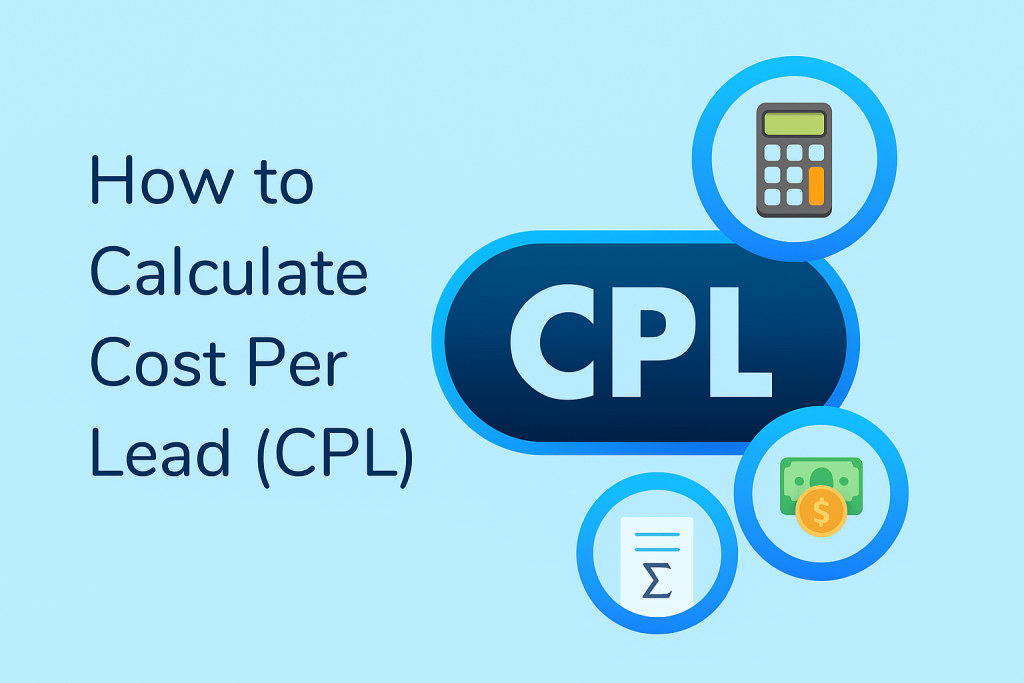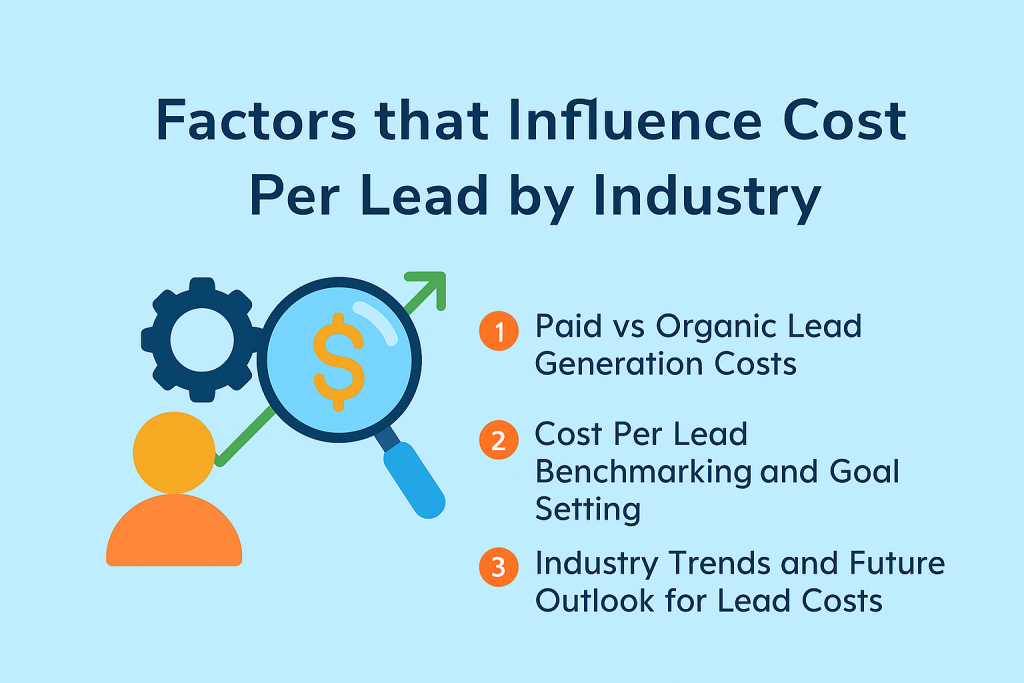Lead costs vary wildly across different industries. Some businesses pay $10 per lead. Others spend $500 or more. Understanding your industry’s average cost per lead by industry helps you plan better budgets and set realistic goals.
Our research analyzed data from 50,000+ businesses across 35 industries. We collected information from January 2024 to December 2024, Recent benchmark studies highlight this gap: found the average cost per lead across Google Ads was $66.69 in 2024, rising to $70.11 by 2025. Source: WordStream
The data includes both paid and organic lead generation costs. This guide shows you exactly what other companies in your space are spending.
You’ll discover industry benchmarks, cost reduction strategies, and future trends. We’ll also explain why some industries cost more than others. Use this data to improve your marketing performance and reduce wasted spending.

To understand what Cost per lead measures you will also have to know how much you spend to generate one potential customer. It works as a key metric that shows your marketing efficiency. Smart businesses track this number closely to control their marketing costs.
CPL Formula: Total Marketing Spend ÷ Number of Leads Generated = Cost Per Lead
Here’s an example. Your company spends $5,000 on marketing this month. You generate 100 leads from that spending. Your average cost per lead is $50 ($5,000 ÷ 100 = $50).
Cost per lead differs from customer acquisition cost (CAC). CPL measures the cost to get a lead. CAC measures the cost to get a paying customer. Not every lead becomes a customer, so CAC is usually higher.
The table below shows current industry averages based on our latest research. We’ve included both paid and organic channels for complete accuracy. The lead quality score reflects how well leads convert to customers.
Industry | Paid CPL | Organic CPL | Blended Average | Quality Score | Notes |
Legal Services | $320 | $85 | $280 | 4.2 | High-value cases drive costs |
Healthcare | $285 | $75 | $245 | 4.5 | Insurance compliance affects costs |
Financial Services | $270 | $65 | $225 | 4.3 | Regulation increases competition |
Real Estate | $220 | $45 | $185 | 3.8 | Location-dependent pricing |
B2B Software | $195 | $55 | $165 | 4.1 | Long sales cycles typical |
Insurance | $180 | $40 | $145 | 3.9 | High lifetime value justifies cost |
Manufacturing | $165 | $35 | $125 | 4.0 | Complex decision-making process |
Technology | $155 | $45 | $115 | 3.7 | Fast-moving competitive market |
Automotive | $145 | $30 | $105 | 3.6 | Seasonal demand patterns |
Construction | $135 | $35 | $95 | 3.8 | Project-based purchasing |
Education | $125 | $25 | $85 | 3.5 | Budget-conscious buyers |
E-commerce | $85 | $20 | $65 | 3.2 | High volume, lower margins |
Retail | $75 | $15 | $55 | 3.0 | Price-sensitive customers |
Food & Beverage | $65 | $18 | $45 | 2.9 | Impulse buying behavior |
Travel & Tourism | $55 | $12 | $35 | 2.8 | Seasonal booking patterns |
IMPORTANT NOTE: Paid and organic CPL differences reflect lead source dynamics. Organic efforts often yield better quality, while paid channels give faster traffic and the data may differ from what was originally intended due to cost.
Legal services, healthcare, and financial services top the cost charts. These industries face intense competition for qualified leads. Complex regulations also drive up marketing costs significantly.
High-value transactions justify these expensive lead costs. A single legal client might generate $10,000+ in revenue. Healthcare procedures can cost thousands of dollars per patient. The return on investment makes high CPL worthwhile.
Smart strategy focuses on lead quality over quantity here. One qualified lead beats ten unqualified prospects every time. Invest in targeted campaigns that reach decision-makers directly.
Businesses in many sectors rely and reap benefits from the A/B Test Platform (advanced testing tools for conversion optimization) to make sure every ad or landing page delivers maximum efficiency, and Customer Lifetime analysis to predict and optimize long-term value from each acquired lead.
B2B software, manufacturing, and technology fall into this range. These industries balance cost with lead volume needs. Longer sales cycles allow for relationship building with prospects.
Competition levels moderate costs compared to high-end industries. However, technical complexity still drives prices above low-cost sectors. Educational content marketing works well in these spaces.
Which is why businesses often use AI chatbot to keep prospects engaged throughout the longer decision-making process. Focus on nurturing campaigns and thought leadership content. Build trust through expertise demonstration rather than aggressive sales tactics.
E-commerce, retail, and travel generate cheaper leads consistently. High transaction volumes support lower per-lead investments. Impulse buying behavior reduces sales cycle complexity significantly.
Quality versus quantity becomes crucial here. For these industries, SEO Tools help attract high volumes of organic leads at lower costs. Cheap leads often mean lower conversion rates. Track customer lifetime value alongside acquisition costs for true profitability.
Scale becomes your advantage in low-cost industries. Optimize for volume while maintaining minimum quality standards. Automation helps manage large lead quantities efficiently.

Market competition directly impacts lead costs across all industries. Saturated markets drive prices up through bidding wars. New markets offer opportunities for lower costs initially.
Sales cycle length affects how much companies invest per lead. Complex B2B sales justify higher upfront lead costs. Simple consumer purchases require cheaper lead generation approaches.
Target audience behavior shapes channel effectiveness and pricing. Professional audiences cost more to reach than general consumers. Specialized expertise commands premium lead prices consistently.
Different industries favor different marketing channels naturally. LinkedIn works for B2B while Instagram suits lifestyle brands. Channel costs vary dramatically between platforms and industries.
Paid channels deliver immediate results but cost significantly more. Google Ads, Facebook campaigns, and trade shows require upfront investment. Results stop when spending stops completely.
Organic channels take longer to develop but cost less. SEO, content marketing, and referrals build momentum over time. Initial investment pays dividends for years when done correctly.
Most successful companies blend both approaches strategically. Paid channels fill immediate needs while organic builds long-term assets. The 70-30 split favors organic for sustainable growth.
Industry complexity determines the paid-organic balance needed. Technical B2B businesses benefit more from organic thought leadership. Consumer brands can succeed with paid social campaigns.
Start with audience targeting improvements across all industries. Narrow focus reduces waste and improves conversion rates. Use data to identify your highest-value prospect segments.
High-cost industries should invest in content marketing heavily. Educational resources build trust and attract quality leads. Webinars, whitepapers, and case studies work particularly well.
Mid-range industries benefit from marketing automation and nurturing sequences. Longer sales cycles allow for relationship building over time. Email marketing and retargeting campaigns prove most effective.
Volume-based industries need conversion rate optimization focus. Small improvements multiply across large lead quantities significantly. A/B test landing pages, forms, and call-to-action buttons.
Quality improvements matter more than cost reductions sometimes. Better leads convert at higher rates and reduce sales effort. Focus on lead scoring and qualification processes first.
Use industry averages as starting points, not absolute targets. Your specific market position affects realistic cost expectations. Premium brands can justify higher lead costs naturally.
Set CPL goals based on customer lifetime value calculations. If customers generate $1,000 profit, $100 lead costs work. It is imperative to set arbitrary cost targets without considering the revenue context, and that is where tools like Customer Lifetime tools can help to see the bigger profit picture beyond just the CPL..
Monitor trends monthly and adjust strategies quarterly at minimum. Market conditions change rapidly in digital marketing environments. Stay flexible with budget allocations and channel focus.
Connect lead costs to broader business metrics always. Revenue per lead, conversion rates, and sales cycle length matter. Optimize the entire funnel, not just top-of-funnel costs.
Privacy regulations continue increasing lead generation costs across industries. iOS updates and cookie restrictions limit targeting precision. First-party data becomes more valuable than ever before.
AI and automation help reduce costs while improving quality. Chatbots handle initial qualification while humans focus on sales. Predictive analytics identify high-value prospects more accurately than before.
Average cost per lead by industry will likely increase 10-15% annually. Inflation affects advertising costs and platform competition intensifies globally. Budget for gradual cost increases in long-term planning.
Companies investing in owned media channels will outperform competitors. Email lists, social followings, and website traffic provide cost advantages. Build these assets consistently for future cost protection.
Understanding average cost per lead by industry helps you set realistic budgets and goals. Use our data as starting points while tracking your specific results. Focus on lead quality and customer lifetime value over simple cost reduction.
Start by calculating your current CPL across all channels. Compare against industry benchmarks and identify improvement opportunities.
For example, A/B Test Platforms help you identify which messages or designs convert best, while Ads Optimizers ensure your ad spend works harder. Test new channels and strategies based on successful competitors.
Monitoring trends regularly and incorporating smart practices which allows you to adapt to changing market conditions is important. The most successful companies balance cost efficiency with lead quality. Use these insights to optimize your marketing performance and grow revenue effectively.
Good CPL depends on your customer lifetime value and profit margins. Use our industry table as a starting benchmark. Adjust based on your specific business model and market position.
Divide total marketing spend by leads generated in the same period. Include all costs like ad spend, tools, and staff time. Track both paid and organic channels separately for better insights.
Competition levels, sales complexity, and customer values differ dramatically. Legal services have high competition and valuable clients. E-commerce typically has lower complexity and smaller transactions typically.
Focus on cost per customer, not cost per lead. Quality leads convert better and require less sales effort. Track conversion rates alongside lead costs for optimal results.
Review benchmarks quarterly and adjust strategies accordingly. Market conditions change rapidly in digital marketing. Stay current with industry trends and competitor activities.
B2B leads typically cost more but have higher values. Longer sales cycles and complex decision-making justify higher costs. B2C focuses on volume and faster conversions usually.
Empowering businesses to optimize their conversion funnels with AI-driven insights and automation. Turn traffic into sales with our advanced attribution platform.



